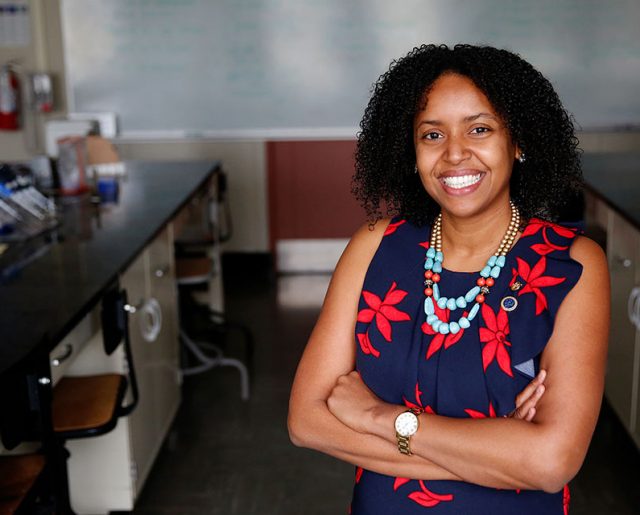
Using crystals to combat bacterial infections
A few years ago, Krystle McLaughlin ’06 realized she has what’s called an aptonym. “It’s when you have a job suited to your name,” says McLaughlin, who uses crystals in much of her scientific work. “I love it. It’s a great way of helping people remember my name at a conference.” Students at Colgate, no doubt, remembered her after an engaging appearance at SophoMORE Connections — the university’s annual career services event in January — when she spoke about her work as a chemistry professor at Vassar College.
To make her crystals, McLaughlin grows proteins in just the right conditions to form beautiful stacks of molecules. Afterward, she analyzes those crystals by subjecting them to X-rays in an attempt to solve the protein’s structure. This process can help with the design of specialized bacteria battlers that may one day be injected inside the body.
All of the projects in McLaughlin’s lab focus on using microbial protein structure to help create therapies that can treat bacterial infections but that do not harm the “good” bacteria inside our bodies. Some of her work focuses on figuring out how to stop the transfer of antibiotic resistance in infections such as staph bacteria infections and Salmonella. In addition, she is examining phages, viruses that can target and kill a particular strain of bacteria with surgical precision, leaving the rest of our microbiome intact. At a time when more and more bacteria are becoming resistant to antibiotics, new tools to potentially combat diseases are particularly valuable.
McLaughlin and her students grow and analyze crystals of essential proteins from these microbes in order to better understand their structures. She then packs those crystals in liquid nitrogen to send to a synchrotron — a huge facility that accelerates beams of electrons to generate X-rays — to figure out what she has. “I am hoping to discover something unique about the proteins. For phages, maybe they hold the key to the specificity, so we can tune the phages to infect any strain we want.”
McLaughlin grew up in Trinidad and Tobago, where she started an environmental club at her school to address rising sea levels and endangered sea turtles. There she met Colgate women’s studies professor Joan Mandle and economics professor Jay Mandle, who used to come to the islands to run basketball referee clinics. “I was the kid who read books on the basketball court,” McLaughlin remembers. Seeing her interest in science, the Mandles encouraged her to apply to Colgate.
She gravitated toward physics but found she was the only woman — and the only woman of color — in the upper-level classes. Today, McLaughlin notes, there is still a lack of diversity in the sciences.
To help address that issue, McLaughlin chairs the Liaison Committee on Underrepresented Minorities at the American Institute of Physics. “At every stage, it gets harder and harder for women and people of color in science because there are less and less people like them,” she says. “If you are going to imagine staying in the field, you need to see yourself represented, to know that science is a place for you as well.”
Through her efforts and recent appearance at Colgate, McLaughlin is serving as a role model for others interested in pursuing the sciences.
— Article by Michael Blanding; photo by Stephanie Veto






